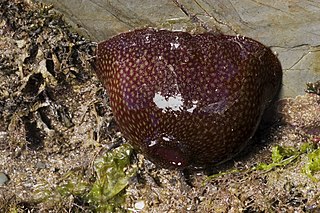
Venom is a type of poison, especially one secreted by an animal. Venom has evolved in a wide variety of animals, both predators and prey, and both vertebrates and invertebrates.

Clownfish or anemonefish are fishes from the subfamily Amphiprioninae in the family Pomacentridae. Thirty species are recognized: one in the genus Premnas, while the remaining are in the genus Amphiprion. In the wild, they all form symbiotic mutualisms with sea anemones. Depending on species, anemonefish are overall yellow, orange, or a reddish or blackish color, and many show white bars or patches. The largest can reach a length of 17 cm, while the smallest barely achieve 7–8 cm.

Anthozoa is a class of marine invertebrates which includes the sea anemones, stony corals and soft corals. Adult anthozoans are almost all attached to the seabed, while their larvae can disperse as part of the plankton. The basic unit of the adult is the polyp; this consists of a cylindrical column topped by a disc with a central mouth surrounded by tentacles. Sea anemones are mostly solitary, but the majority of corals are colonial, being formed by the budding of new polyps from an original, founding individual. Colonies are strengthened by calcium carbonate and other materials and take various massive, plate-like, bushy or leafy forms.

Heteractis magnifica, also known by the common names magnificent sea anemone or Ritteri anemone, is a species of sea anemone belonging to the Stichodactylidae family native to the Indo-Pacific area.

The sebae anemone, also known as leathery sea anemone, long tentacle anemone, or purple tip anemone, is a species of sea anemone belonging to the family Stichodactylidae and native to the Indo-Pacific area.

The starlet sea anemone is a species of small sea anemone in the family Edwardsiidae native to the east coast of the United States, with introduced populations along the coast of southeast England and the west coast of the United States. Populations have also been located in Nova Scotia, Canada. This sea anemone is found in the shallow brackish water of coastal lagoons and salt marshes where its slender column is usually buried in the mud and its tentacles exposed. Its genome has been sequenced and it is cultivated in the laboratory as a model organism, but the IUCN has listed it as being a "Vulnerable species" in the wild.

Actinia fragacea, commonly known as the strawberry anemone, is a species of sea anemone of the order Actiniaria, that occurs from Norway to Africa, including adjacent islands and the Mediterranean. It is generally found on rocks of the lower shoreline and depths up to 8–10 metres (26–33 ft).

The beadlet anemone is a common sea anemone found on rocky shores around all coasts of the British Isles. Its range extends to the rest of Western Europe and the Mediterranean Sea, and along the Atlantic coast of Africa as far south as South Africa.

Stichodactyla mertensii, commonly known as Mertens' carpet sea anemone, is a species of sea anemones in the family Stichodactylidae. It is regarded as the largest sea anemone with a diameter of over 1 m (3.3 ft), the next largest being Heteractis magnifica, which has longer tentacles. This species has an oral disc that can be described as more ovoid than circular that contours to the surrounding substrate and is attached to the substrate by adhesive verrucae, which are wart-like projections. Its blunt or pointed tentacles are uniformly shaped, and are only about 1–2 centimetres (0.39–0.79 in) long. It contains obligate symbiotic zooxanthellae, and is a host to around half the species of anemonefish and one damselfish, Dascyllus trimaculatus.

Sea anemones are the marine, predatory animals of the order Actiniaria. They are named after the anemone, a terrestrial flowering plant, because of the colourful appearance of many. Sea anemones are classified in the phylum Cnidaria, class Anthozoa, subclass Hexacorallia. As cnidarians, sea anemones are related to corals, jellyfish, tube-dwelling anemones, and Hydra. Unlike jellyfish, sea anemones do not have a medusa stage in their life cycle.

Alicia is a genus of sea anemones in the family Aliciidae and contains the following species:

Alicia mirabilis, commonly known as the berried anemone, is a species of sea anemone in the family Aliciidae. It changes shape as night falls expanding its column and tentacles to catch its food. It can be found in the Azores, Portugal, Spain and the Mediterranean and Red Seas.

Alicia rhadina is a species of sea anemone in the family Aliciidae. It is found in the Southern Ocean.

The walking anemone, also known as the hedgehog anemone or sock anemone, is a species of sea anemones in the order Actiniaria. It is the only member of its genus, Preactis.

Alicia pretiosa is a species of sea anemone in the family Aliciidae and can be found in the Red Sea and South Pacific Ocean.

Edwardsiella andrillae is a species of sea anemone that uniquely lives anchored to the underside of sea ice offshore of Antarctica. It was discovered in December 2010 during a test run of an undersea robot by a team of researchers associated with the Antarctic Geological Drilling (ANDRILL) Program. The newly discovered anemone was named for the aforementioned program.

Spurilla neapolitana, the Neapolitan spurilla, is a species of sea slug, an aeolid nudibranch, a marine gastropod mollusk in the family Aeolidiidae. It is native to the western Atlantic Ocean, the Caribbean Sea and the Mediterranean Sea. This species was first described as Eolis neapolitana by the Italian naturalist Stefano delle Chiaje in 1841. However, although some authorities quote the year as 1823, the species does not appear in the first volume of delle Chiaje's memoirs, which was published that year. The species was later reassigned to the genus Spurilla.
Allantactis is a monotypic genus of sea anemones, and Allantactis parasitica is the only species in the genus. This sea anemone lives at bathyal depths in the North Atlantic Ocean and has a symbiotic relationship with a gastropod mollusc.
















